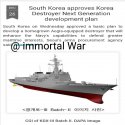Jura The idiot
General
interesting assortment
Inside South Korea’s military wish list, as it seeks greater control over its forces
Inside South Korea’s military wish list, as it seeks greater control over its forces
... goes on below due to size limit:When South Korean President Moon Jae-in visited the White House this month, U.S. President Donald Trump used the meeting to tout that the Asian nation plans to buy of a large amount of American weapons systems .
“President Moon [Jae-in] and South Korea have agreed to purchase a tremendous amount of our military equipment, from jet fighters to missiles, to ,” Trump said at the April 11 meeting, where North Korea’s stalled denuclearization topped the agenda. “And we make the finest equipment in the world by far, and we appreciate the purchase. It’s a very large purchase.”
South Korea’s presidential office and military procurement authorities have since been tight-lipped about what might be in that “very large purchase.” But local defense experts and industry sources tell Defense News that acquisition decisions will focus on airborne systems with a price tag reaching 10 trillion won (U.S. $8.8 billion) over the next five to six years.
“A key motive for U.S. weapons purchase is the planned transfer of wartime operational control from the U.S. military to the South Korean armed forces,” said Shin Jong-woo, a senior analyst at the Seoul-based Korea Defense and Security Forum think tank. “What we need now to lead wartime operations in the years ahead is to get more and better airborne weapons systems, which would be preferential purchasing items.”
The South Korean government is accelerating efforts to take back authority to control its armed forces during wartime by 2022. An American four-star general currently is responsible for the maneuvers of both U.S. and South Korean troops on the Korean Peninsula in the event of war, and South Korean forces are heavily dependent on American airborne equipment for wartime deterrence.
Priority planes
Of the items considered for purchase, stealth fighter jets are at the top of the list, according to procurement and industry sources.
The Defense Acquisition Program Administration, or DAPA, has completed preliminary research on the purchase of 20 more F-35As from the U.S. government, according to South Korean Air Force and industry sources. In 2014, Seoul ordered 40 F-35As, built by Lockheed Martin, through the Pentagon’s Foreign Military Sales program.
“The procurement agency has launched a feasibility study on the additional purchase of F-35As, and the request for proposal, or RFI, is to be issued early next year,” a military source involved in the preliminary research told Defense News on condition of anonymity. “ wants the first delivery of the second batch to start in 2021, but the schedule could be slipped a little bit.”
Funding for this effort will be about $3 billion, according to the source.
Airborne systems for intelligence, surveillance and reconnaissance are also on the purchase list as part of midterm force improvement plans from 2019 to 2023, according to South Korean procurement sources.
The Defense Agency for Technology and Quality, an affiliate of DAPA, launched studies last year for a , or JSTARS. The 2019-2023 budget for midterm force improvement, which was released in January, detailed plans to acquire at least .
The budget for that acquisition is estimated at $1.7 billion, a DAPA source told Defense News. “The agency issued a request for information, and a couple of foreign potential bidders responded to the request,” the source said.
Among the bidders are Boeing, Raytheon and Israel Aerospace Industries’ Elta Systems. Boeing offered a P-8 Poseidon-based aircraft fitted with Raytheon’s Advanced Airborne Sensor radar capable of wide-range ground surveillance operations.
Raytheon proposed its , based on the Bombardier Global Express business jet. The aircraft is equipped with a dual-mode, synthetic aperture radar and moving target indication radar, and is currently flown by the British Royal Air Force.
Elta is known to be marketing its multimission airborne reconnaissance and surveillance system, dubbed “Mars2,” based on the Gulfstream G550 business jet.
“JSTARS is a key asset required for the transfer of wartime operational control, as the South Korean military for itself seeks to expand it operational capabilities,” said Kim Dae-young, an analyst at the Korea Research Institute for National Strategy. “A key criterion is expected to be how much the system has been proven in the battlefield, and export control issues could be an agenda item.”
Along with the JSTARS, the South Korean Air Force plans to buy two more . The service now operates four Boeing-built 737 AEW&C aircraft equipped with Northrop Grumman’s multirole electronically scanned array radar.
Sweden’s Saab has thrown its hat into the ring to challenge Boeing by proposing its GlobalEye AEW&C based on a modified Bombardier Global 6000 aircraft. Elta is also known to be a competitor.
In addition, the Air Force is considering buying six to eight electronic warfare aircraft similar to the Boeing-built EA-18G Growler.
...









